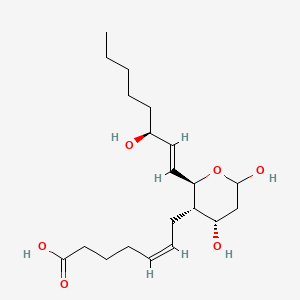Thromboxane b2
Thromboxane b2 is a lipid of Fatty Acyls (FA) class. Thromboxane b2 is associated with abnormalities such as endothelial dysfunction, Diabetes Mellitus, Non-Insulin-Dependent, Diabetes Mellitus, Ischemia and Thrombocytosis. The involved functions are known as Platelet Activation, Excretory function, Anabolism, Inflammation and mRNA Expression. Thromboxane b2 often locates in Endothelium, Hepatic and Microsomes, Liver. The associated genes with Thromboxane b2 are PTGS2 gene, prothrombin fragment 2 and CCL14 wt Allele.
Cross Reference
Introduction
To understand associated biological information of Thromboxane b2, we collected biological information of abnormalities, associated pathways, cellular/molecular locations, biological functions, related genes/proteins, lipids and common seen animal/experimental models with organized paragraphs from literatures.
What diseases are associated with Thromboxane b2?
Thromboxane b2 is suspected in endothelial dysfunction, Diabetes Mellitus, Non-Insulin-Dependent, Diabetes Mellitus, Ischemia, Thrombocytosis, Acute Coronary Syndrome and other diseases in descending order of the highest number of associated sentences.
Related references are mostly published in these journals:
| Disease | Cross reference | Weighted score | Related literature |
|---|
Possible diseases from mapped MeSH terms on references
We collected disease MeSH terms mapped to the references associated with Thromboxane b2
PubChem Associated disorders and diseases
What pathways are associated with Thromboxane b2
There are no associated biomedical information in the current reference collection.
PubChem Biomolecular Interactions and Pathways
Link to PubChem Biomolecular Interactions and PathwaysWhat cellular locations are associated with Thromboxane b2?
Visualization in cellular structure
Associated locations are in red color. Not associated locations are in black.
Related references are published most in these journals:
| Location | Cross reference | Weighted score | Related literatures |
|---|
What functions are associated with Thromboxane b2?
Related references are published most in these journals:
| Function | Cross reference | Weighted score | Related literatures |
|---|
What lipids are associated with Thromboxane b2?
There are no associated biomedical information in the current reference collection.
What genes are associated with Thromboxane b2?
Related references are published most in these journals:
| Gene | Cross reference | Weighted score | Related literatures |
|---|
What common seen animal models are associated with Thromboxane b2?
There are no associated biomedical information in the current reference collection.
NCBI Entrez Crosslinks
All references with Thromboxane b2
Download all related citations| Authors | Title | Published | Journal | PubMed Link |
|---|---|---|---|---|
| Jiang J et al. | Effect of Marine-Derived n-3 Polyunsaturated Fatty Acids on Major Eicosanoids: A Systematic Review and Meta-Analysis from 18 Randomized Controlled Trials. | 2016 | PLoS ONE | pmid:26808318 |
| Gonzalez-Paredes FJ et al. | Contribution of Cyclooxygenase End Products and Oxidative Stress to Intrahepatic Endothelial Dysfunction in Early Non-Alcoholic Fatty Liver Disease. | 2016 | PLoS ONE | pmid:27227672 |
| Kakouros N et al. | Risk Factors for Nonplatelet Thromboxane Generation After Coronary Artery Bypass Graft Surgery. | 2016 | J Am Heart Assoc | pmid:27068626 |
| Becerra AZ et al. | Increases in ambient particulate matter air pollution, acute changes in platelet function, and effect modification by aspirin and omega-3 fatty acids: A panel study. | 2016 | J. Toxicol. Environ. Health Part A | pmid:27029326 |
| Homoródi N et al. | The lack of aspirin resistance in patients with coronary artery disease. | 2016 | J Transl Med | pmid:26980433 |
| Wannhoff A et al. | Cardiac volume overload and pulmonary hypertension in long-term follow-up of patients with a transjugular intrahepatic portosystemic shunt. | 2016 | Aliment. Pharmacol. Ther. | pmid:26919285 |
| Taneja A et al. | Biomarker exposure-response relationships as the basis for rational dose selection: Lessons from a simulation exercise using a selective COX-2 inhibitor. | 2016 | J Clin Pharmacol | pmid:26331692 |
| Siewiera K et al. | Long-term untreated streptozotocin-diabetes leads to increased expression and elevated activity of prostaglandin H2 synthase in blood platelets. | 2016 | Platelets | pmid:26325148 |
| Sugita R et al. | A novel selective prostaglandin E2 synthesis inhibitor relieves pyrexia and arthritis in Guinea pigs inflammatory models. | 2016 | J. Pharmacol. Sci. | pmid:26906248 |
| Yan H et al. | Seawater Immersion Aggravates Burn Injury Causing Severe Blood Coagulation Dysfunction. | 2016 | Biomed Res Int | pmid:26885523 |
